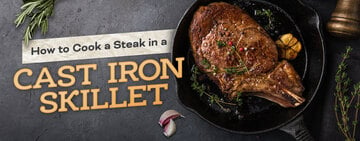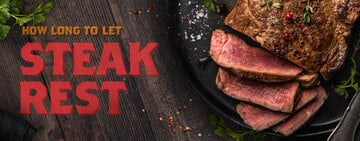Burnt ends are slow-smoked, cubed, and caramelized pieces of meat beloved for their sweet flavor and soft-as-butter texture. Made from either brisket or pork belly meat, they're almost as fatty as butter, too. Despite their name, burnt ends aren’t burnt at all. Their toothsome, BBQ bark crust gives them a burnt appearance but is chewy and tastes like smoked spices and meat. BBQ bark develops when dry rub, smoke, and meat proteins combine, initiating a chemical reaction that develops the flavorsome “bark”. Whether you're learning how to smoke meat to open a barbeque restaurant or expanding your existing menu, your customers will crave the delicious debauchery that is burnt ends. Read on to learn everything you need to know about burnt ends so you can add them to your menu. Click below to learn more about burnt ends: Burnt Ends Ingredients/Flavor Types of Burnt Ends How to Make Brisket Burnt Ends How to Make Pork Belly Burnt Ends How to Serve Burnt Ends Burnt Ends FAQ What Are Burnt Ends Made Out Of? Burnt ends are made from fatty cuts of smoked meat. Once the meat reaches its desired internal temperature, pitmasters dress it in Kansas City-style BBQ sauce which they caramelize in smoke. What Do Burnt Ends Taste Like? Burnt ends taste like rich, smoked beef caramelized in the sweet molasses beauty of Kansas City barbecue sauce. Despite their name and charred appearance, burnt ends don't taste burnt. The spices on the meat harden when smoked, creating a flavorsome layer of barbeque bark that has a similar consistency to jerky. When you first bite into burnt ends, your teeth are met with resistance from the dense barbeque bark crust. Breaking through, a burst of juice erupts as the meat releases the fat it absorbed during its long, low and slow smoking process. A deep umami flavor arrests your tastebuds. You chew the bark while the meat melts in your mouth. Before you know it, the bite is gone, so you reach for another burnt end. What Meat Is Burnt Ends? Both cow and pig meat are used to create burnt ends. Cow’s meat burnt ends come from the point half of a brisket. Pitmasters use pork belly to create pig meat burnt ends. Popularized in the 1970s, brisket burnt ends are both the most traditional and most popular type of burnt ends. Modern pitmasters also make burnt ends out of pork belly meat, which has a similar fat-to-protein ratio as brisket. We explain the intricacies of brisket burnt ends and pork belly burnt ends below. What Are Brisket Burnt Ends? Brisket burnt ends are cubed, sauced, and smoked pieces of point brisket. These sweet bites of succulent smoky beef are the classic and most common type of burnt ends. Brisket burnt ends are the signature dish of Kansas City-style BBQ. When smoked, the fatty brisket point cut crisps and is hard to slice. When making brisket sandwiches, most pitmasters discard the flavorful, crispy brisket point. But not Bryant’s Barbeque. Bryant’s Barbeque, a renowned restaurant in Kansas City, Missouri, chopped smoked brisket point into cubes and handed them to queued customers as a free snack. Food writer Calvin Trill, a Kansas City native, spread the word about Bryant’s Barbeque, and burnt ends captured the hearts and tastebuds of BBQ aficionados nationwide. What Are Pork Belly Burnt Ends? Pork belly burnt ends are cubed pieces of pork belly meat that are slow-smoked, sauced, and then finished to yield a caramelized, sweet, and buttery flavor. While brisket burnt ends originated to reduce food waste by utilizing the discarded pieces of brisket from sliced brisket sandwiches, people prepare pork belly burnt ends for their own sake. When pitmasters realized just how delicious brisket burnt ends are, they prepared pork belly meat in the same way. Most unprocessed pork belly contains approximately 48% fat. When trimmed and cooked, brisket typically has a 50% fat content. So, while they come from two distinct animals, you can prepare brisket meat and pork belly meat the same way and achieve similar results. Back to Top How to Make Burnt Ends You make burnt ends by smoking cubed brisket point pieces low and slow, slathering them in sauce, and then giving them a final, caramelizing caress of smoke. Discover the fundamentals of how to make burnt ends so you can serve up authentic Kansas City flavor anywhere you park your smoker. Separate the brisket point from the flat. Trim leftover hard fat on the bottom of the point and the fat cap on top. You want them to be 1/4 inch thick. Smoke the brisket with low heat over an extended cook time. Many pitmasters swear that 250 degrees Fahrenheit is the best temperature to smoke brisket at. At 250 degrees Fahrenheit, expect the beef brisket to cook at a rate of 1 to 1 1/2 hours per pound. Once the internal temperature reaches 195 degrees Fahrenheit, remove the smoked point and cut it into cubes. Shoot for 1 to 1 1/2 inch cube sizes. Sauce the cubed meat in sweet Kansas City BBQ sauce. Smoke the burnt ends in an uncovered pan for another hour or two. When you remove them, they should have absorbed the sweet sauce and will have a melt-in-your mouth consistency. How to Make Pork Belly Burnt Ends You’ll need to smoke pork belly for three to four hours to make pork belly burnt ends. We provide some tips and tricks for how to select the best cut of pork belly meat and how to make pork belly burnt ends below. Buy pork belly meat that has a balanced fat-to-meat ratio by asking your butcher for the center cut of the belly. Pure fat cubes will not render. Discard them. Preheat your smoker to 250 degrees Fahrenheit. Remove any remaining skin. The skin won’t render. Cut the pork belly into 1 1/2 to 2-inch-sized cubes. Add dry rub or other desired seasonings. Place your pork belly cubes on a wire rack before adding them to your smoker. This aids smoke circulation and makes it easier to move the cubes in and out of the smoker. Smoke the pork belly cubes for approximately 3 1/2 hours to cook them and imbue them with smoke. When the internal temperature of your pork belly cubes reaches 165 degrees Fahrenheit, remove them and sauce with Kansas City-style BBQ sauce or the sauce of your choosing. Put them in a heat-proof disposable pan and smoke them until they reach your desired level of caramelization. Expect this to take approximately 45 minutes. Let them rest covered outside of the smoker for an additional 15 minutes. The meat will continue to absorb the sauce. Enjoy your crunchy on the outside, juicy on the inside pork belly burnt ends. What to Serve with Burnt Ends What you should serve with burnt ends depends on whether you’re using them as an appetizer or as the centerpiece of your entree. Both crunchy and juicy, burnt ends also make a great mix-in for side dishes like baked beans. Whether you’re serving brisket or pork belly, discover what to eat with burnt ends below: Serve burnt ends between a bun as a sandwich. While they don’t lay flat and stay put like sliced brisket, these flavorful bites release their juice into the bun and create a messy but delicious BBQ sandwich option. Serve burnt ends in baked beans. Kansas City-style baked beans get their rich flavor from burnt ends, which soften when they’re simmered with these sweet and saucy baked beans. Serve burnt ends with Carolina-style red slaw. While mayo-based coleslaw is traditional for Kansas City BBQ, we recommend blending traditions and pairing burnt ends with the signature red vinegar-based coleslaw of the Carolinas. This tangy, light, vinegar-dressed coleslaw is a nice complement to the rich burnt ends. Serve burnt ends with roasted sweet potato. Just like burnt ends, roasted sweet potatoes are crispy on the outside and tender on the inside, making them textural twins. Dress them in BBQ sauce to add moisture. Serve burnt ends as the protein in a BBQ boat. Many BBQ food trucks allow their customers to build a BBQ boat by layering two sides and the protein of their choice in a banana split boat. Serve burnt ends in BBQ tacos. Particularly if you use pork belly burnt ends, this is a fun twist on traditional tacos. BBQ restaurants can offer burnt ends tacos as a taco Tuesday special, or restaurants can promote them as a happy hour menu item. Serve burnt ends with mac and cheese. This is an indulgent pairing, but the tender noodles and creamy consistency of mac and cheese pair perfectly with the toothsome BBQ bark and juicy center of burnt ends. The flavors of smoke, cheese, and grain culminate in a filling dish that satiates appetites and indulges senses. Serve burnt ends on kababs with grilled vegetables. This is a great option for catered events and mobile food vendors who want to offer a portable food option. You could also serve them on food picks as an appetizer tray item at weddings and corporate events. Serve burnt ends with roasted Brussels sprouts. Brussels and bacon are a classic combination, so reinvent the tradition by using burnt ends instead. Burnt ends and bacon are equally rich, but burnt ends bring smoke and sweetness to the table. Replace the traditional balsamic glaze with BBQ sauce and you’ve got a down-home version of a bistro classic that will prove life really is sweeter in the South. Serve burnt ends inside a bao bun. Create a fusion twist on a street food classic and replace BBQ pork with burnt ends inside a bao bun. The soft, doughy bao creates a pleasant contrast to the chewy, sumptuous burnt-end meat. Back to Top Burnt Ends BBQ FAQ Knowing what burnt ends are, how to prepare them, and what to serve them with is a start, but you probably have a few more questions about this smoked meat candy before you add it to your menu. We answer frequently asked questions about burnt ends below, so you can confidently incorporate this menu trend. How to Get Bark on Brisket Brisket bark is a key element of scrumptious burnt ends, but how do you get bark on brisket? Follow the tips below to develop flavorful and crunchy brisket bark on your burnt ends: Rub meat with oil before adding dry rub - Oil picks up smoke. Use a high sugar dry rub - Sugar helps build bark on brisket. Spray the brisket while it smokes - Spray once an hour while the internal temperature builds to 165 degrees Fahrenheit. Once it reaches 165, wrap the brisket in butcher paper - The butcher paper protects the bark and retains moisture. Once wrapped, continue to smoke the brisket until it reaches the internal temperature of 203 degrees Fahrenheit. Once it reaches 203 degrees Fahrenheit, unwrap and finish with a last kiss of smoke - This will redevelop any bark that was washed away by pooled liquid in the butcher paper. Are Burnt Ends Fatty? Yes, burnt ends are fatty. Made from either brisket meat or pork belly meat, burnt ends contain approximately 50% fat content. However, burnt ends are not just crispy, juicy nuggets of fat. Burnt ends are made from the point cut of a brisket, which comes from the brisket primal (aka the pectoralis minor muscle). Brisket point has a dense layer of fat coating it as well as plentiful intramuscular fat marbling, but it is still a cut of meat. When making brisket burnt ends, they leave the fat layer intact to render the meat while it cooks, which imbues the meat with rich flavor. Burnt Ends vs Brisket Technically, burnt ends and brisket are the same things. Burnt ends are the trimmings from a smoked brisket. During the smoking process, the point cut of the brisket develops a rich, smoky bark and crunchy texture. Pitmasters trim off this flavorful section, cut them into cubes, sauce them, and then kiss them with smoke to caramelize them. These bites of BBQ bark and caramelized, well-marbled meat are known as burnt ends. Some pitmasters use pork belly meat to make burnt ends, but they prepare it in the same way as brisket burnt ends. What Part of Brisket Is Burnt Ends? Burnt ends come from the point half of a smoked brisket. The point half is the superficial pectoral. It is also called the “second cut” because when butchers separate the brisket muscles; they first remove the deep pectoral known as the “first cut” or the “flat cut”. The point half is also known as the “fat end” because it is much fattier than the lean, deep pectoral cut. Rib Tips vs Burnt Ends Rib tips and burnt ends are not the same things. Burnt ends are the BBQ bark-laden edges of slow-smoked brisket, and rib tips come from the short section butchers remove when they prepare squared-off ribs cuts like St. Louis style spareribs. They are distinct cuts of meat from separate animals, and they interact with heat differently. The heat cooks the fat off rib tips, but burnt ends absorb fat, giving them a richer flavor and juicier texture. How to Reheat Burnt Ends Burnt ends reheat well. We show you how to reheat burnt ends with your oven, smoker, and stovetop below. How to Reheat Burnt Ends in the Oven - To reheat burnt ends in the oven, preheat your oven to 350 degrees Fahrenheit. Place the burnt ends in a disposable aluminum pan and apply a fresh coat of barbeque sauce. Wrap the pan in aluminum foil, and warm it in the oven for 20 to 24 minutes. How to Reheat Burnt Ends in the Smoker - If you’d like to reheat your burnt ends in your smoker, preheat your smoker to 225 degrees Fahrenheit. Then, place the burnt ends in a heat-resistant disposable tray. Lightly reapply your sauce and warm them for 30 minutes. How to Reheat Burnt Ends on the Stove - To reheat burnt ends on the stove, seal them in a bag with a vacuum sealer. Take a large pot and add 3 quarts of water for each pound of meat. Bring the water to a boil. Place your vacuum-sealed bag inside the pot. Turn off the heat and remove the pot from the hot burner. Let the burnt ends rest in the water for 15 minutes, then remove the bag. Cut open the vacuum bag and remove the burnt ends. You can follow a similar process with the sous vide method to reheat your brisket without drying it out. Are Burnt Ends Pork or Beef? The most traditional burnt ends come from beef, specifically from the brisket point cut. However, given their popularity, some modern pitmasters prepare pork belly in the same style as brisket burnt ends to recreate this tender-centered, crunchy-edged delicacy with pork meat. Unless labeled as pork belly burnt ends, expect to receive beef burnt ends when you order them at a BBQ restaurant. If you have a food allergy, ask your server to confirm whether the burnt ends are brisket or pork belly meat. Burnt Ends BBQ Sauce As the hallmark dish of Kansas City style BBQ, Kansas City style BBQ sauce is the traditional finishing touch for burnt ends. Kansas City-style BBQ sauce is a fail-proof choice because it is the most popular type of barbecue sauce. Ketchup-based and swirled with molasses, this high sugar content sauce is an addicting staple in pantries nationwide. If you want to blend BBQ traditions, try dressing your burnt ends in Carolina Gold BBQ sauce or North Carolina vinegar BBQ sauce for tangy twists that will cut some of the fat in the burnt ends and produce balanced flavor bites. If you want to keep some of the sweetness but add some tang, try Memphis-style BBQ sauce. Fusion chefs may choose to sauce their burnt ends in bulgogi sauce or a tamarind chutney to blend the American BBQ tradition with global flavors. What Is National Burnt Ends Day? National burnt ends day is a national food holiday that takes place on September 1st. Offer a burnt end special on September 1st or host a burnt ends cookoff event at your restaurant to attract customers. Are Burnt Ends Healthy? Made from fatty cuts of meat and slathered in a sugar-rich sauce, burnt ends are not a healthy choice. Burnt ends pack a powerful protein punch, with an average of 27g of protein per one cup of smoked beef brisket burnt ends, which appeals to those wanting to add more protein to their diet. However, the allure of burnt ends is their decadence, not their health benefits. Back to Top Made from an inexpensive cut of meat, burnt ends are affordable to create. They reduce food waste by utilizing every morsel of delicious smoked brisket. Whether you serve them as an appetizer, entree, or add them to your favorite side dish, burnt ends will be the crown jewel of your menu.






